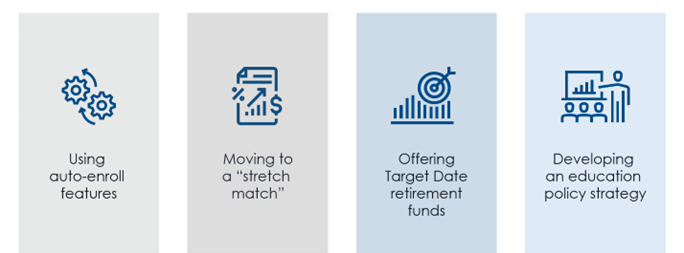Viewpoints from Charles Brown
The first quarter of 2024 is almost over, and if you haven’t taken steps to help ensure that your retirement plan benefits are working for you and your employees, now is the perfect opportunity because a seismic shift in retirement plan benefits is happening.
The 401(k) and 403(b) were a boon to employers in the 1980s when legislation enabled them to replace the pension plan as the primary retirement benefits investment vehicle. Employers saw they could shift the risk onto the employee and reduce their costs, so there was a push away from defined benefit plans into defined contribution plans.
Time and experience have revealed that something important was missing, however. There wasn’t enough of an emphasis on employee education to help them understand that retirement savings were now their responsibility and that they should take an active role in planning for their retirement. We’re seeing a gap today as people are nearing retirement without enough saved for their post-work life. In effect, they’re unable to retire on their own terms.
The SECURE 2.0 Act aims to remedy that with regulations that are coming on board from 2023 through 2026. SECURE is an acronym for Setting Every Community Up for Retirement Enhancement.
What SECURE 2.0 Act means for plan sponsors
This act has both challenges and opportunities for plan sponsors. At its core, its intention is to incentivize employers to sponsor retirement plans and incentivize employees to contribute to them. It has a whopping 94 provisions that plan sponsors will be challenged to keep up with as regulations for them roll out over the next couple of years.
Let’s look at three of the most significant provisions. The biggest change is the long-term, part-time employee rule; the one getting the most notice is the optional student loan payment matching; and there’s a provision for emergency savings accounts.
On the plus side for employers, there are also several tax credits for starting plans and opportunities for making plans more attractive to current and potential employees.
Financial wellness: SECURE opportunities for employee engagement
Employers tell us that attracting and retaining top talent and enabling employees to retire on their own terms are their two top reasons for offering retirement plan benefits. There has been a shift in how retirement benefits are considered part of an integrated wellness plan for employees; financial wellness is an important aspect of overall wellness and employee productivity.
New long-term, part-time employee requirements
Many companies have long-term, part-time employees who have been traditionally excluded from participation in the retirement benefits plan. The new law says that long-term, part-time employees who work for more than 500 hours a year are now eligible to participate in the deferral portion of the plan. It’s up to you to define whether they are eligible for an employer contribution match.
If your plan has a vesting schedule, the law requires that people who have entered the plan as long-term, part-time employees be vested for every year that they work 500 hours. Even if your defined vesting schedule requires 1,000 hours to get credit for a year of service for vesting, the person who comes into the plan under this long-term, part-time rule must only work 500 hours.
While it’s possible to treat disparate populations differently—different deferrals, different matches—many employers are choosing to simplify and treat everyone the same by lowering the eligibility requirements to allow part-time employees in the plan under the normal rules.
Optional student loan matching program
This provision is getting the most attention right now. It allows an employer to make an annual matching contribution treating an employee’s student loan payments like deferral contributions. Basically, a person making $2,000 in student loan payments would get the same employer match as a person making $2,000 in deferrals.
Many new workers are stretched financially. While paying back student loans, they often forgo participation in their employer’s retirement plan. The new regulations allow an employer to make match contributions to an employee’s plan in the amount of their student loan payments. The employee self-certifies the total amount they paid in a year on student loans, the employer makes an equal contribution to their retirement account, and you have some instant goodwill with an employee.
This is a feature that can help you attract and retain younger talent, and it seems that everyone is talking about it. Add this to your “employer of choice” strategy, and it turns into a recruitment and retention tool.
If you see retirement benefits as an important part of your employee wellness portfolio, your employees will, too.
Emergency Savings Plans
There’s a provision for emergency savings accounts into which an employee can contribute up to $2,500 after tax. It’s a benefit to the employee to have access to emergency cash, and it’s also an administrative benefit to the employer because it could reduce the number of loans and hardship distributions that are requested.
In addition to regulatory complexity, there’s an increase in legal action against plan sponsors by participants for lack of fiduciary oversight. So, while employers are managing these new regulations on one hand, they must also make sure they’re working in the employee’s best interest as a fiduciary.
Retirement benefits as an important part of your employee wellness portfolio
You can take an active role in empowering employees to reach their retirement goals by:

Fill out this short form to download your copy of our 3 Steps to Start Leveraging Your Retirement Benefits to help ensure you’re making the best decisions in the current employment and regulatory landscape.“*” indicates required fields
Best practices for fiduciary risk mitigation
Fiduciary oversight has become more important in retirement plans over the years with a shift in responsibility back to employers. Last year, the Department of Labor issued $1.4 billion in fines on retirement plans. Their auditors are incentivized to find areas of concern, so it’s important that you don’t have any. What are they looking for?
- Governance: Are the people making decisions on behalf of the plan within the company authorized to do so? Do they have a charter with board resolutions? Are meeting minutes documented and accessible for a potential audit? Often, the people making decisions on behalf of the plan have no authority to do so, such as an “investment committee” or a couple of people tapped for the task.
- Investment policy statement: This dictates how investment decisions are made and other decisions around the plan. You must document that you have an investment policy statement that you adhere to.
- Fees and benchmarking: Do you have recordkeeping that documents all sources of revenue? It’s the employer’s responsibility to benchmark fees and ensure that they’re reasonable; there is a huge gap in those who don’t. In 2012, the Department of Labor issued fee disclosure regulations.
If this sounds overwhelming, it is. Consider outsourcing the fiduciary responsibility. Imagine the peace of mind you’ll have when the auditors come knocking, and you’re able to have a third party hand over all documentation to the Department of Labor. It’s a pretty quick audit because they realize that the plan is well-planned, operated and supervised, so they move on. That’s the benefit of working with a consultant and outsourcing some of that fiduciary liability to a third party.
It’s more important than ever for plan sponsors to engage with and leverage their relationships with their plan service providers (e.g., TPAs, attorneys, brokers, etc.). Pay attention to their communication as they try to help you keep up with the legislation and compliance regulations.
Attention to retirement plan benefits often falls to the bottom of the to-do list, but it shouldn’t. You may think it’s easier not to think about them, but it’s a topic you can’t ignore—especially now that you’re in the fiduciary hot seat! With these regulations and increasing fiduciary responsibility, you likely need expert advice to navigate the landscape.
You don’t have to go it alone. To reduce complexity and liability, you can outsource fiduciary oversight to a third party. There’s even a new option for employers to offload fiduciary responsibility and liability into a pooled employer plan (PEP). These plans have no individual audit costs and provide reduced liability. PEPs provide a pre-existing structure with an administrator and investments that employers can adopt and move forward.
Our free retirement benefits plan evaluation can help you assess your current retirement benefits, evaluate your governance efforts, measure the effectiveness of your service provider and identify corrective actions.
Download our actionable resource, 3 Steps to Start Leveraging Your Retirement Benefits, through the form on this page and learn more about how we can help you conduct a complimentary retirement plan readiness evaluation.
Contact the Author
Charles Brown, EA, MSEA, QPA, QKA, CSPO, Consulting Actuary | MAI Retirement, an Affiliate of EPIC | Contact Charles via phone or email.
EPIC offers this material for general information only. EPIC does not intend this material to be, nor may any person receiving this information construe or rely on this material as, tax or legal advice. The matters addressed in this document and any related discussions or correspondence should be reviewed and discussed with legal counsel prior to acting or relying on these materials.
Related Content
Products
Employee Benefits Consulting
Our dedicated benefits team is focused on delivering better outcomes – to both your benefits program and ...
Products
Actuarial
Our Actuarial Team provides guidance on employee benefits and health and welfare programs to help meet ...
Products
Compliance
We provide comprehensive consulting services and in-depth education regarding the ever-changing employee ...


